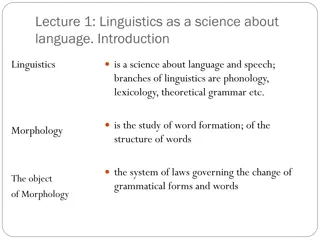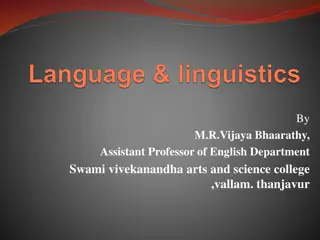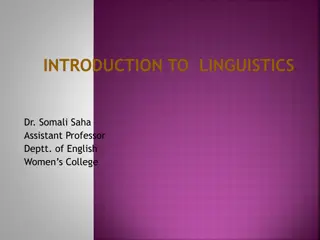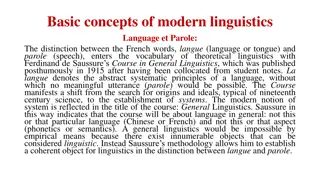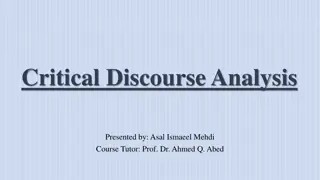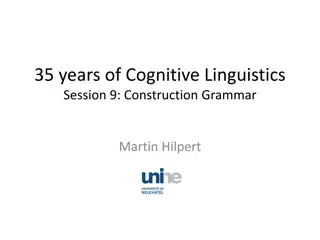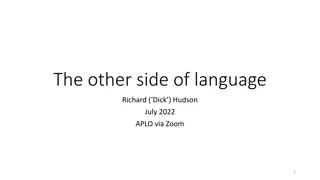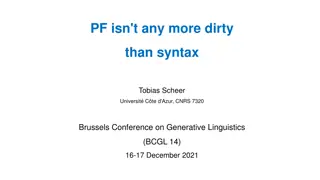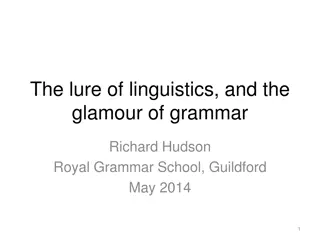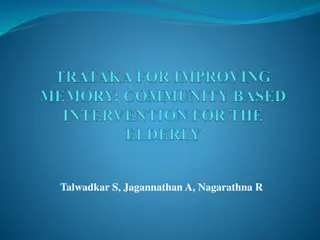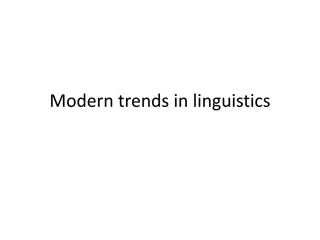Exploring Cognitive Linguistics: A Modern Approach to Language Analysis
Cognitive linguistics is an approach that views language as interconnected with cognitive capacities, emphasizing language's role in organizing and conveying information. It examines how linguistic structures reflect conceptual organization, categorization principles, and environmental influences, highlighting the integration of language with world knowledge and cognitive processes.
- Cognitive Linguistics
- Language Analysis
- Linguistic Trends
- Cognitive Capacities
- Information Processing
Download Presentation

Please find below an Image/Link to download the presentation.
The content on the website is provided AS IS for your information and personal use only. It may not be sold, licensed, or shared on other websites without obtaining consent from the author. Download presentation by click this link. If you encounter any issues during the download, it is possible that the publisher has removed the file from their server.
E N D
Presentation Transcript
Modern trends in linguistics 1. Cognitive linguistics. 2. Functional grammar. 3. Text linguistics. 4. Communicative linguistics.
Linguistics in the 20thcentury comparative linguistics structural linguistics communicative linguistics genesis system function
Cognitive linguistics Cognitive linguistics is an approach to the analysis of natural language that originated in the late 1970s and early 1980s in the work of US linguists George Lakoff, Ron Langacker, and Len Talmy, and that focuses on language as an instrument for organizing, processing, and conveying information. It emerged as a reaction against the dominant generative paradigm.
Cognitive linguistics language is not autonomous, it is embedded in the overall cognitive capacities of man; there is no autonomous linguistic faculty in human mind the formal structures of language are studied as reflections of general conceptual organization, categorization principles, processing mechanisms, and experiential and environmental influences linguistic knowledge involves not just knowledge of the language, but knowledge of the world as mediated by the language knowledge of language arises out of language use; the study of language is the study of language use
Cognitive linguistics our interaction with the world is mediated through informational structures in the mind natural language is a means for organizing, processing, and conveying that information. language is seen as a repository of world knowledge, a structured collection of meaningful categories that help us deal with new experiences and store information about old ones.
Cognitive linguistics Three fundamental characteristics of Cognitive Linguistics: the primacy of semantics in linguistic analysis (the primary function of language is categorization, it involves meaning) the encyclopedic nature of linguistic meaning (world knowledge is associated with linguistic forms) the perspectival nature of linguistic meaning (the world is not objectively reflected in the language: the categorization function of the language imposes a structure on the world rather than just mirroring objective reality)
Functional grammar Alexander Bondarko (1930-2016) Functional Grammar: A Field Approach the author of the theory of Functional Semantic Fields (FSF)
Functional grammar FSF is a system of language units of various levels (lexical, morphological, syntactical) which perform the same function on the basis of their common categorial content (modality, temporality, possessiveness, aspectuality, intensity etc.)
Text linguistics Text linguistics is a branch of linguistics concerned with the description and analysis of extended texts (either spoken or written) in communicative contexts. Text linguistics overlaps considerably with discourse analysis.
Text linguistics Approaches to the study of texts text grammar (Van Dijk) aims to establish a model with which the grammatical structures of texts can be described (quite similar to Chomsky s transformational approach). text linguistics is devoted to describing how texts are created and understood and in so doing studies the defining properties of texts - what constitutes their textuality or texture (Crystal). discourse analysis (Renkema, Schiffrin) traditionally analyses chiefly written texts. However, it seems that it is very difficult to define discourse precisely - Schiffrin (1994) for example says that discourse analysis ... is one of the most vast, but also least defined, areas in linguistics .
Text linguistics A text is defined as a communicative occurrence which meets seven standards (principles) of textuality: cohesion, coherence, intentionality, acceptability, informativity, contextuality and intertextuality.
Text linguistics Cohesion M.Halliday , R.Hasan Cohesion in English (1976) The concept of cohesion accounts for the essential semantic relations whereby any passage of speech or writing is enabled to function as text Categories of cohesion provide a practical means for describing and analysing texts. They are explicitly expressed in a text: reference, substitution, ellipse, conjunction lexical cohesion (synonymy, antonymy, collocation).
Text linguistics Coherence Coherence is probably the main component of any form of textual study because if a text is not fully understood a good text was not produced. What makes a text coherent ? What makes some texts acceptable and others unacceptable ? A coherent text has an underlying logical structure that acts to guide the reader through the text so that it sticks together as a unit and creates the feeling that a text hangs together, that it makes sense, and is not just a jumble of sentences.
Text linguistics Contextuality focuses on the role the context plays in any form of communication. I In every situation in which language is used, the quality and effect of the communication is determined by the contextual knowledge shared by the participants. This aspect of language use is studied by pragmatics and sociolinguistics. Pragmatics focuses on what the participants in a discourse intend to accomplish through the use of the language (what speech act is performed in a given setting). Sociolinguistics aims to determine the role knowledge of the participants (as human beings and in the environment they function as such) plays in the success of a communicative occurrence.
Text linguistics Text linguistics is a kind of umbrella discipline which makes the study of the different disciplines of linguistics more relevant. Principle of textuality Linguistic sub-disciplines Cohesion Syntax Semantics Morphology Phonology Coherence Semantics Cognitive linguistics Intentionality Pragmatics Acceptability Pragmatics Informativity Semantics Syntax Contextuality Pragmatics Sociolinguistics Intertextuality Literature theory
Communicative linguistics Paul Grice (1913-1988), British philosopher of language Maxims of effective communication Maxim of Quality Supermaxim: Try to make your contribution one that is true Submaxims: Do not say what you believe to be false. Do not say that for which you lack adequate evidence. Maxim of Quantity Make your contribution as informative as is required (for the current purposes of the exchange). Do not make your contribution more informative than is required. Maxim of Relevance Be Relevant Maxim of Manner Supermaxim: Be clear and keen Submaxims: Avoid obscurity of expression. Avoid ambiguity. Be brief. Be orderly.
Communicative linguistics Speech-act theory is a subfield of pragmatics concerned with the ways in which words can be used not only to present information but also to carry out actions. As introduced by Oxford philosopher J.L. Austin ( How to Do Things With Words , 1962) and further developed by American philosopher J.R. Searle, speech-act theory considers the levels of action at which utterances are said to perform: Locutionary Acts Illocutionary Acts Perlocutionary Acts
Communicative linguistics Communicative competence refers to both the knowledge of a language and the ability to use it effectively. The concept of communicative competence (a term coined by linguist Dell Hymes in 1972) grew out of resistance to the concept of linguistic competence introduced by Noam Chomsky (1965). Most scholars now consider linguistic competence to be a part of communicative competence.




